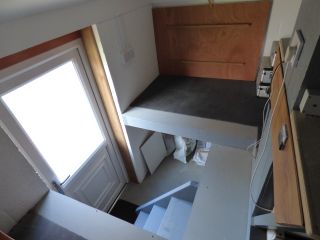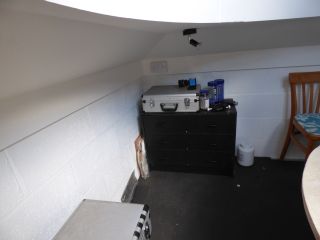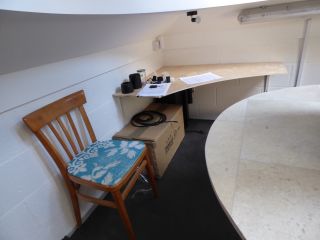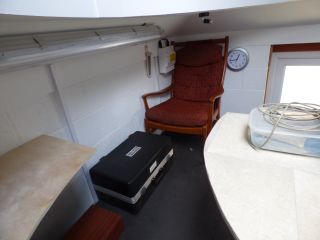I expect this to be the last page of this saga. No doubt there will be other minor alterations, but I don't have anything more planned as far as the observatory itself is concerned.
 |
I explained the need for an extra piece of floor in Part 12 . You can see the floor stood up against the wall. Note it has two battens screwed to the underside. These have three functions: 1. They strengthen the board, 2. They act as handles to help when manoeuvring it into place, and 3. They are just shorter than the width of the hole, so they serve to locate the board in the right place. Move your mouse over the image to see the board in place. You can also see here that I have covered the whole floor with play matting. These interlocking tiles are made of a soft but resilient material and serve to protect anything I may drop (filters seem quite common). |
The nature of the building means that I have four corners with very low ceilings which are useful extra space. You see into one (the north-west corner) above which houses the extra floor board and where the light switches are. In addition to the light switches, I have a main switch which turns off all the power sockets so that I can be sure I have switched everything off. I show each of the other corners below.
 |
This is the north-east corner and houses a small chest of drawers where I keep all sorts of bits and pieces; eyepieces, filters, adaptors, and various others things that might be needed. You will see that its top is acting as a storage shelf and holds one of four flight cases. These are a relic of the days before I had an observatory and needed to take all my bits and pieces outside each clear night. I still use them. Although not strictly air tight, I do keep silica gel in them to keep the contents dry. One holds my smaller cameras (DMK, DFK and my old 840K webcam), a second holds larger cameras or ones I never use (two Atics and a Trust webcam), a third houses my ST80, and I don't remember what is in the fourth. |
 |
This is the south-east corner. I have put a large shelf here. It fits into the corner and is cut to the curve of the dome so that it doesn't stick out. I am notoriously untidy and this gives me somewhere to dump things so that I can keep the desk clear. It is supported by four metal brackets. I have covered the desk with vinyl floor covering (left over from our utility-room extension); the original ply was getting rather grubby because I have to stand on it when changing the telescope on the mount. Under the shelf there is the box in which the RC was delivered and into which it goes when not on the mount. The box for the LX200 is far too large and it stored on the ground floor and contains the original fork mount. The LX200 is stored face down in the corner.
|
 |
This is the south-west corner. The chair is a bit of a luxury. It was one of the things that shouldn't have come with us when we moved but it did and there was really nowhere else to keep it. It is quite nice when the camera is taking pictures and there is really nothing for me to do but it is not worth going inside. In my last place I used to wander around the garden looking up at the stars. That is not really possible here as there are far too many bright lights around, but the disadvantage of a dome is that that restricts my view of the sky too. The disadvantage of the chair is I am likely to drop asleep. The clock is one of these radio-controlled clocks so I always know the exact time if I need to. You can just see the small light over the chair. This is one of four red lights; one in each corner. I have decided I need to fit them with switches as I don't always want them all on or off. The box is the hard case for the ETX where (believe it or not) I keep my ETX125. The little brown box you can just see at the very bottom of the picture is a small step I originally made to help my disabled mother up into her shower. Now it is handy when I can't quite see through the telescope or its finder. If I need any more height I stand on the little chair (the one in the picture above). Also in this corner are the main electric input trip switches and a very old max-min thermometer. Along the top-left corner you can see the white light, a rather over-sized fluorescent light which I seldom use.
|
The things you see on the desk in the last of the pictures above are concerned with the MX716 camera. The coil of wire is the USB cable from a box fixed to the pillar. It could come off and be put away. The box houses the camera when not in use. It is connected to the box fixed to the pillar by a hefty cable with D-type connectors on each end. I have had problems with these connectors so I prefer not to keep removing them which means the camera is permanently connected to the pillar. I have a hole cut in the side to take the cable and I keep silica gel inside to keep the camera dry. The hole means it is not completely air tight but it serves its purpose.
I have tidied up the cables coming down the pillar. Sticky tape hasn't worked well and I found some sticky clips that hold them more neatly. An extension to the handbox cable has been essential and now ends with a socket stuck to the top surface of the wooden cladding to the pillar. This has proved secure and holds against the tension of the springy cable which stretches to wherever it is needed (if rather inconveniently—I hate to think where it would go if I let it go). It would be even more convenient if the cable came out of the top of the paddle instead of the bottom. I'm thinking about that one.
The only last thing to mention is the ground floor. Apart from a mat at the door in case the ground is wet outside, it is valuable storage space, albeit with only about a meter of head room. Currently I have the boxes for the LX200 and the mount down there, and I keep our stock of bird food there (mice get into the garage). We spend a small fortune feeding the birds, mostly goldfinches but we do get invaded by starlings at times.
All in all, I am very pleased with my new observatory. If I was doing it again, would I do it differently? Undoubtedly, yes, but the opportunity is most unlikely to arise.
Home
Back to Equipment





